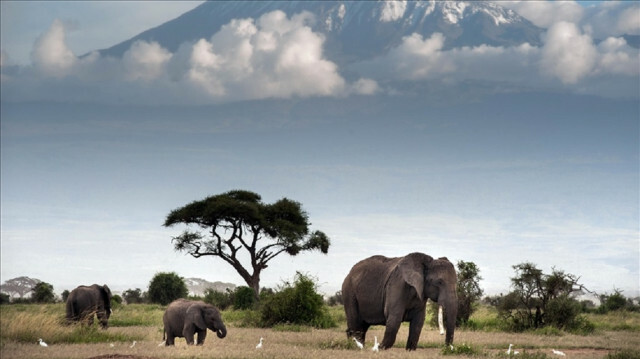

File photo
Environmental experts say melting glaciers have led to unnamed wetlands, lakes in Amboseli National Park
The snows of Tanzania’s Mt. Kilimanjaro are rapidly disappearing and this is having a drastic consequence for wildlife and the environment at Amboseli National Park.
Residents, including 72-year-old Stephen Koitalel, who has lived on the foothills of the snowcapped mountain have seen it in transition since he was a child.
“Every morning as a child when I took the cows out to graze, I could see the snow, the mountain was so clear back then. There was snow everywhere covering not only the top part of the mountain like it does today, but stretching close to the mid-section, said Koitalel. “It was a beautiful sight for everyone and people used to pray and hold initiation ceremonies such as circumcision and weddings while facing the mountain. Nowadays, the snow is thin, barely visible, it used to be a huge chunk of white snow. I don’t know what happened to the snow but it just disappeared.”
Lekumok Lakamai, a 53-year-old nomadic pastoralist from the Entonet area of Kajiado County, echoed those sentiments. “When growing up, my parents used to tell me that there was so much snow on the mountain, even our grandparents told us folk stories based on the mountains passed down from generation to generation. We can’t tell our kids such stories today because there is no snow to talk about,” he said.
What Koitalel and Lakamai, who have never heard the term, “climate change,” do not know is that the warming climate has resulted in the melting of the snow over the years.
The UN has warned that rising temperatures are leading to the disappearance of glaciers found on only three mountains in Africa -- Mt. Kilimanjaro, Mt. Kenya and the Rwenzori Mountains -- which are expected to melt entirely in the near future.
- Melting snow cause wetlands attracting flamingoes
Anadolu Agency spoke to Dr. Patrick Omondi, the chief executive officer of Wildlife Research and Training Institute in Kenya, about the effects that melting glaciers have had on the ecosystem. He said the melting snow has turned a large area of the 151 square miles (392 square kilometers) Amboseli National Park into a wetland.
He said the melting of the Kilimanjaro glacier has had positive and negative effects. On the Kenyan side, the results have been positive.
“It is positive because Amboseli was not originally a wetland area. The melting glaciers now have filtered through and created swamps. Amboseli has now become a new bird paradise, we have birds like flamingos which we used not to have here before and we are actually thinking of naming Amboseli as one of the international wetlands of importance,” said the top Kenyan researcher.
The drastic climatic change has brought the pink-feathered birds that stand on impossibly thin legs to Amboseli where there is abundant food in swamps. According to scientists, the snow form on Kilimanjaro and immediately melts because of the warm temperature. The cycle forms an uninterrupted supply of underground water that flows down the mountain to the park.
“These swamps serve the local communities occasionally when they come to give water to their animals when the drought is high, and like now, when the drought is here, this is a permanent water source, so it has helped,” said Omondi.
Despite a severe drought in that part of Kenya, park life is thriving with water and swampy grasslands everywhere. Elephants can be seen wallowing in the mud and other animals like Zebras and wildebeests feeding on pasture.
The melting Kilimanjaro has positive effects on the Kenyan side but devastating effects in Tanzania.
In Loitoktok, on the Kenyan side, residents complain of low water levels.
“The melting of the mountain on the other side is not very good. There are high temperatures that come with droughts meaning animals disperse wide and far and it escalates human-wildlife conflict,” said Omondi.
Paleo-climatologists have warned that melting glaciers will lead to fewer water resources for communities living around the mountain especially on the Tanzanian side. Streams and rivers originating from the mountain have either dried up or have lower volumes of water.
Kenya Wildlife Service Director-General John Waweru told Anadolu Agency that two lakes have formed in Amboseli due to global warming.
“The water that is in the Amboseli system is water that actually comes from Mount Kilimanjaro through underground rivers. We have noticed that there are two lakes that are now forming which have not been named yet, but of course, there is a plan to name them in the near future,” he said.
#Kilimanjaro
#Kenya
#Melting
